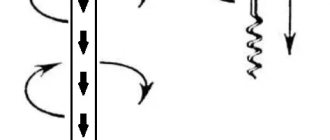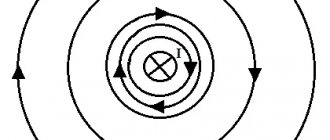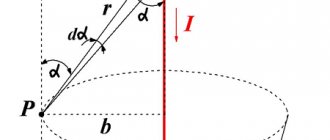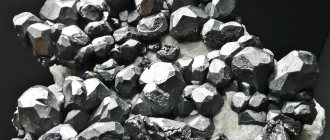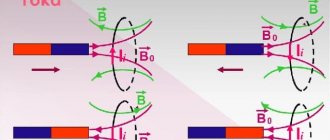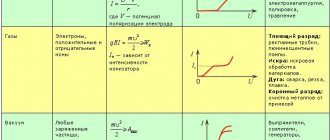Permanent magnets. What is this?
The Chinese, like the Greeks, also noticed the interesting property of some minerals to attract iron-containing objects. The Chinese associate the word “attract” with the words “to cuddle” and “to love” and therefore called such minerals “chu-shi”, which means “loving stone”. Since these minerals were created by nature, and man could not influence the natural action of the stones, they began to be called permanent magnets.
It is now known that the natural mineral magnetic iron ore (magnetite) manifests itself in such an interesting way. This is a fairly fragile black mineral, its density is approximately 5000 kg/m3.
Magnetic iron ore.
Ancient people attributed the properties of a “living soul” to magnetic iron ore. The mineral, they said, rushed to the iron like a dog to a piece of meat. Scientists explain the attitude of the ancients to natural phenomena by ignorance of physics.
In fact, everything lies in a special type of matter - a field.
The magnetic field attracts iron objects to a permanent magnet, because, for example, small nails or buttons rush to the magnet even without contacting it, but at some distance.
Magnetite (natural magnetic iron ore) does not exhibit very strong attractive properties. Man has created artificial magnets with a more powerful magnetic field based on it. The materials used in them are metals such as cobalt, nickel and, of course, iron. Such metals are capable of magnetization when exposed to a magnetic field, and then become independent magnets.
Different forms of artificial magnets. Source
Whatever shape a magnet has, it has areas where its magnetic properties are most pronounced. These areas are called magnetic poles. Every magnet, even the smallest one, has two poles. Modern technologies make it possible to magnetize metal objects so that they form both 4 and 6 poles.
You can see how differently iron filings are attracted to a magnet in a simple experiment with an arched school magnet. Just bring a magnet to the sawdust, the sawdust will immediately “stick” to it:
Arc magnet.
The poles of such a magnet will be the edges of the arc, where the most iron filings have accumulated.
A strip magnet, shaped like a rectangular parallelepiped, has poles far apart from each other. The closer to the middle, the less magnetic properties appear.
Strip magnet.
Questions and tasks
- Where is the magnetic induction vector directed at point A
, lying on the bisector of the angle formed by the currents
I
1 and
I
2 shown in the figure?
Wires from a current source are connected
to opposite vertices A
and
C
the AKCD diamond What is the magnetic induction at the center of the rhombus? the AKC
rhombus is made of copper wire, and the
ADC
is made of aluminum of the same section?- A constant voltage is applied to the most distant vertices of a cubic frame made of homogeneous wire. What is the magnetic field induction in the center of the cube when currents flow along its edges?
- Two identical circular wire conductors, having a common center and located in perpendicular planes, carry identical currents. The magnitude of the magnetic induction vector at the common center is equal
to B. What will be the magnetic induction at the same point if the previous current flows through only one conductor? - Current I
flowing through a wire bent into a circle of radius
R
creates
a magnetic field at its center, the absolute value of which is equal to
B. What will be the field induction at the center of the semicircle O
if the wire has the form shown in the figure? - A conductor made of soft wire lies on a flat, smooth surface. What shape will a wire take if a sufficiently strong current is passed through it?
- How will the solenoid turns interact with each other if the following flows through them: a) direct current; b) alternating current?
- Two rigid, loose straight wires crossing at right angles carry currents I
1 and
I
2. How will the relative position of the wires change immediately after the currents are turned on? - How will a small magnetic needle be positioned when placed in the center of a tightly wound coil connected to a current source?
- Why do they use bifilar winding in resistance coils? Why do they wind a wire folded in half around a rod so that both ends are side by side?
- The lightning rod was connected to the ground using a thin-walled metal tube. Why did the tube instantly turn into a round rod after a lightning strike?
- What will happen to a current-carrying frame placed in the magnetic fields shown in the figure?
- A wire ring carrying current is freely suspended on soft lead wires and encloses a horizontal cylindrical permanent magnet in the middle. What happens to the ring if the direction of the current in it is reversed?
- A superconducting ring with current “floats” in a magnetic field as shown in the figure. In which direction does the current flow on the side of the ring closest to the reader?
- How to make an electromagnet whose lifting force could be adjusted?
- Is it possible to build a strong electromagnet if the condition is that the current in it be relatively small?
South and north indicator - compass. Magnetic poles
“South indicator” is what the ancient Chinese called their invention. It was a spoon-shaped device made from a natural magnet. The spoon could rotate around a vertical axis.
Ancient Chinese compass.
The handle of the spoon pointed south. She was the north pole of the spoon magnet.
The development of science has not stopped, and modern compasses already have a different look:
Different types of compasses.
The magnetic needle, the main element of the compass, is a permanent magnet and has two poles. The end of the arrow pointing to the geographic North is called the north (N), and the opposite end is the south (S) pole. Hence the name of the poles of various magnets.
The coloring of magnets in red and blue is conventional; other colors are used less frequently. The important thing is that the poles of magnets only exist in pairs. If you cut, for example, a strip magnet, you will get two strip magnets, and they will again have two poles: north and south.
School labs use small magnets on a stand that fit onto a thin needle and can rotate freely around the needle. Such devices are called magnetic needles, similar to compass needles.
Using arrows, the interaction of magnet poles is studied. If you bring the arrows closer to each other, they begin to rotate and are positioned according to the following rule:
The globe is a huge magnet that has its own poles. But the Earth's magnetic poles should not be confused with geographic ones. According to the rule, the blue (north) end of the arrow should turn towards the South Pole of the globe, since opposite poles attract. Yes, indeed, this is so. The Earth's South Magnetic Pole is located near the North Geographic Pole, but not at the same point, but slightly to the side, on Prince of Wales Island. The North Magnetic Pole is located in Antarctica, where the South Geographic Pole is.
Source
The location of the Earth's magnetic poles does not remain constant. The poles shift by a distance of several tens of kilometers per year.
The list of areas where magnets are used is very wide:
- automotive industry;
- instrument making;
- automation;
- telemechanics;
- braking systems;
- compasses;
- medicine;
- radio engineering;
- electrical engineering.
From the study of natural magnetic phenomena, man has long since moved on to electromagnetic phenomena, without which the development of knowledge about electricity and electric current is impossible.
Magnetic effect of electric current: examples
In technological processes and everyday life, the magnetic properties of current are used in dozens of cases:
- Separator purposes are the purification of substances, such as food, from metal inclusions. Magnets remove metals from bulk materials: steel, iron, cast iron, and their alloys.
- Devices for separating charged particles.
- Magnetization of liquids and aqueous solutions.
- Cranes for loading, unloading, sorting metals. At the operator’s command, an electric current is passed through a strong electromagnet, which turns on/off the magnetic field, attracting or releasing scrap metal at the right moments.
- Control of microorganisms by influencing them with field formations.
- Electric motors - the operating principle is based on electromagnetic induction - the conversion of electrical energy into mechanical energy.
- A generator is a device for converting energy from one type to another.
- Magnetic plates that fix workpieces processed on grinding machines.
- Transport – magnetic locks, sensors.
- Medicine: magnetic resonance imaging.
- Actuating devices: switches, switches, valves.
- Computer equipment: hard drives, speakers.
The Earth's magnetic field, which Gilbert wrote about, is felt and used by animals. Birds use it to navigate during flights and other animals during migrations.
Give examples of the magnetic action of current that you yourself have encountered.
Graphic representation of fields
Magnets act on each other and on iron-containing objects through a magnetic field. The field has no color, no smell, and cannot be felt. This is a special type of matter, which is manifested by its action on another field or on physical bodies.
Conventionally, a magnetic field is depicted using lines of force, just like an electric field.
These lines are closed, that is, they have neither beginning nor end. The direction in which the north poles of magnetic needles point in the field of a magnet is taken as the direction of the magnetic field lines. This is the direction from the north pole to the south.
Although the image of lines of force is taken as conventional, they still appear in a simple experiment with iron filings. If you put a magnet on a piece of paper and sprinkle it with small iron filings, you can see how they line up along certain lines, like little magnetic arrows.
The frequency of the lines around the magnet is different. This highlights the stronger effect of the magnetic field near the poles, where the field lines are denser.
Basic properties and characteristics of the magnetic field.
Electromagnetism
A magnetic field
- this is matter that arises around sources of electric current, as well as around permanent magnets (Fig. 1.1). In space, the magnetic field is displayed as a combination of forces that can influence magnetized bodies. This action is explained by the presence of driving discharges at the molecular level.
1.1 A magnetic field is formed only around electric charges that are in motion. That is why the magnetic and electric fields are integral and together form the electromagnetic field
. The components of the magnetic field are interconnected and influence each other, changing their properties.
Properties of magnetic field:
1. A magnetic field arises under the influence of driving charges of electric current.
2. At any point, a magnetic field is characterized by a vector of a physical quantity called magnetic induction
, which is a force characteristic of a magnetic field. 3. A magnetic field can only affect magnets, current-carrying conductors and moving charges. 4. The magnetic field can be of a constant or variable type 5. The magnetic field is measured only by special instruments and cannot be perceived by human senses. 6. The magnetic field is electrodynamic, since it is generated only by the movement of charged particles and affects only charges that are in motion. 7. Charged particles move along a perpendicular trajectory.
The size of the magnetic field depends on the rate of change of the magnetic field. According to this feature, there are two types of magnetic field: dynamic magnetic
field
and
gravitational magnetic field
.
The gravitational magnetic field
arises only near elementary particles and is formed depending on the structural features of these particles.
A magnetic moment occurs when a magnetic field acts on a conductive frame.
In other words, the magnetic moment is a vector that is located on the line that runs perpendicular to the frame. The magnetic field can be represented graphically using magnetic field lines. These lines are drawn in such a direction that the direction of the field forces coincides with the direction of the field line itself. Magnetic lines of force are continuous and closed at the same time.
The direction of the magnetic field is determined using a magnetic needle. The lines of force also determine the polarity of the magnet, the end with the output of the force lines is the north pole, and the end with the input of these lines is the south pole.
It is very convenient to visually evaluate the magnetic field using ordinary iron filings and a piece of paper. If we put a sheet of paper on a permanent magnet and sprinkle sawdust on top, then the iron particles will line up according to the magnetic field lines.
The direction of the power lines for a conductor is conveniently determined by the famous gimlet rule
or
the right hand rule
(Fig. 1.2)
.
If we wrap our hand around the conductor so that the thumb points in the direction of the current (from plus to minus), then the 4 remaining fingers will show us the direction of the magnetic field lines.
Rice. 1.2
· Ampere's law
Ampere's law
shows the force with which a magnetic field acts on a conductor placed in it. This force is also called the Ampere force.
Statement of the law: the force acting on a current-carrying conductor placed in a uniform magnetic field is proportional to the length of the conductor, the magnetic induction vector, the current strength and the sine of the angle between the magnetic induction vector and the conductor.
The energy contained in a magnetic field can manifest itself in the form of electromagnetic forces, which arise when the magnetic field interacts with moving electric charges
50
If you place a conductor with current I in a magnetic field, then electromagnetic forces will arise between the electrons passing through the conductor and the magnetic field, which, adding up, form a resultant force F, tending to push the conductor out of the magnetic field. The electromagnetic force F acting on a current-carrying conductor located in a magnetic field and located perpendicular to the direction of the field is equal to the product of the current strength I, the magnetic field induction B and the length of the conductor:
.
If the conductor is located at an angle α to the magnetic force, then the force, N,
.
The direction of action of force F is usually determined by the left-hand rule (Fig. 1.3).
Rice. 1.3
As a result of the influence of such mechanical forces, with the same direction of current, adjacent conductors will be attracted to each other (Fig. 1.4, a), with different directions of current, they will repel (Fig. 1.4, b). The design of various electrical machines and instruments, for example, measuring instruments of a magnetoelectric system, is based on the phenomenon of interaction of a magnetic field and a conductor with current. Particularly large forces between conductors arise in electrical circuits during short circuits.
a) b)
Rice. 1.4 Interaction of two conductors with current: a) with the same direction of the current; b) with different directions of current
· Characteristics of the magnetic field
Magnetic induction. The intensity of a magnetic field is characterized by magnetic induction B. The stronger the magnetic field created by a permanent magnet or electromagnet, the greater the induction it has. The direction of action of the electromagnetic force F on the conductor is determined by the left-hand rule (Fig. 1.3).
If you position your left hand so that the magnetic lines penetrate the palm, and the extended four fingers indicate the direction of the current in the conductor, then the bent thumb will indicate the direction of the electromagnetic force.
By this force one can judge the intensity of the magnetic field, i.e. its magnetic induction. If a 1 m long conductor with a current of 1 A, located perpendicular to the magnetic lines in a uniform magnetic field, is acted upon by a force of 1 N, then the magnetic induction of such a field is equal to 1 T (tesla).
Magnetic induction
is a vector quantity
: at each point in the field, the magnetic induction vector is directed tangentially to the magnetic lines of force.
Magnetic flux. The quantity measured by the product of magnetic induction B and area S perpendicular to the magnetic induction vector is called magnetic flux Ф:
F=BS.
Magnetic induction is expressed in teslas, and area is expressed in square meters, so the unit of magnetic flux is weber:
1 Wb = 1 T ∙ 1
Magnetomotive force
.
The ability of a current to excite a magnetic field is characterized by a magnetomotive force (MF)
acting along a closed magnetic field line. Magnetomotive force is equal to the current creating a magnetic field and is expressed in amperes.
For a conductor with current I, the MMF is equal to the current I. In the general case, when a closed loop of a magnetic field line covers several currents, the total MMF is equal to the sum of the currents.
For a coil with the number of turns w and current I (Fig. 1.5), the MMF is equal to
ƩI=Iw.
Magnetic field strength
.
The magnetomotive force per unit length of a magnetic field line is called magnetic
field strength H and is expressed in amperes per meter (A/m).
If the physical conditions along the entire length I of the magnetic line are the same, then
.
For example, around a straight conductor with current I, the magnetic field lines are concentric circles of variable radius x, the length of each of which is I = 2 x. In this case, tension.
.
As you move away from the conductor, the field strength decreases.
Rice. 1.5. Toroidal coil
Magnetic permeability
.
Magnetic induction depends not only on the strength of the current passing through a straight conductor or inductive coil, but also on the properties of the medium in which the magnetic field is created. The quantity characterizing the magnetic properties of a medium is absolute magnetic permeability
. It is determined by the ratio of magnetic induction B to magnetic field strength H and is measured in henry per meter (H/m):
.
Absolute magnetic permeability of vacuum = 4π ∙ H/m. For air and other non-ferromagnetic materials, it differs slightly from the magnetic permeability of vacuum and for technical calculations is taken equal to 4π ∙ H/m. Since the absolute magnetic permeability for vacuum and the previously mentioned materials is almost the same, it is called the magnetic constant
.
The absolute magnetic permeability of ferromagnetic materials is not constant and is many times higher than the magnetic permeability of vacuum. The number indicating how many times the absolute magnetic permeability of a ferromagnetic material is greater than the magnetic constant is called relative magnetic permeability
, or (abbreviated) magnetic permeability:
.
Magnetic properties of matter
Permanent magnets can be made from only relatively few substances, but all substances placed in a magnetic field are magnetized, that is, they themselves become sources of a magnetic field. As a result, the magnetic induction vector in the presence of matter differs from the magnetic induction vector in a vacuum.
Definition
Magnetic permeability of a substance
μ shows how many times the magnetic induction vector in a substance is greater than the magnetic induction vector in a vacuum, that is
=μ⋅
The magnetic properties of a substance are determined by how these substances react to an external magnetic field and how their internal structure is ordered. There are three main classes of substances with sharply different magnetic properties: ferromagnetic, paramagnetic and diamagnetic.
Substances that, like iron, have μ≫1, are called ferromagnets
.
The most important property of ferromagnets is the existence of residual magnetism. Permanent magnets are made from ferromagnets.
However, when heated to a sufficiently high temperature, the ferromagnetic properties of bodies disappear (Curie point).
The temperature at which a substance loses its ferromagnetic properties is called the temperature or Curie point
.
| Iron (Fe) | 77 C |
| Nickel (Ni) | 36 C |
| Cobalt (Co) | 100 C |
When a permanent magnet is heated above this temperature, it stops attracting iron objects. The magnetic permeability of ferromagnets is not constant; it depends on the magnetic induction of the external field.
There are substances that behave like iron, i.e. are drawn into a magnetic field. These substances are called paramagnetic
. They have μ>1, but differ from unity by an amount of the order of .
The magnetic permeability of paramagnetic materials depends on temperature and decreases as it increases. Without a magnetizing field, paramagnetic materials do not create their own magnetic field. There are no permanent paramagnets.
Diamagnets
- substances that are pushed out of a magnetic field. For diamagnetic materials, μ<1 differs from unity by an amount of the order of .
Magnetic permeability is practically independent of the magnetizing field induction and temperature. When a diamagnetic material is removed from an external magnetizing field, it is completely demagnetized and does not create a magnetic field.
Superconductors are ideal diamagnets. The magnetic field does not penetrate into the superconductor at all. This means that a superconductor is an ideal diamagnetic. Since the magnetic induction inside the conductor is zero, then according to the formula =μ⋅ the magnetic permeability μ of the superconductor is also zero.
· Magnetization of a ferromagnet. Magnetization stages.
The magnetization of ferromagnets is a process consisting of several stages.
At the first stage, as the strength of the external magnetic field increases, the sizes of those domains whose own magnetic moment forms an acute angle with the external field increase. At the same time, the volume of those domains for which this angle is obtuse decreases.
______________________________
* Typically the domain dimensions are 10-4...10-5 m.
By the end of the first stage, domains in which the mentioned angle is acute completely absorb those in which the angle between their own and external magnetic fields is obtuse.
This magnetization stage is called the boundary displacement stage.
At the second stage, a further increase in the strength of the external magnetic field causes the magnetic moments of the domains to rotate towards the external magnetic field.
The second stage of magnetization is called the rotation stage.
By the end of the second stage, the magnetic moments of all domains are directed along the external magnetic field. At the end of this stage, the third stage of magnetization begins - the saturation stage.
During the first and second stages of magnetization, the field inside the ferromagnet grows due to an increase in both the external magnetic field and the magnetic field created by the domains.
At the third stage, the increase in the magnetic field in the ferromagnet occurs only due to the increase in the external magnetic field. The total magnetic field of the domains does not change.
· Hysteresis phenomenon
If we reduce the magnetic field that caused the magnetization of the ferromagnet, it turns out that the dependence of the magnetic field induction in the ferromagnet on the strength of the external magnetic field does not coincide with the initial magnetization curve.
When the external magnetic field strength decreases to zero, the magnetic field in the ferromagnet will not decrease to zero. The magnetic field induction in a ferromagnet will be equal to B
ost – residual field induction in a ferromagnet. In other words, the ferromagnetic sample will remain magnetized after turning off the external magnetic field.
In order to reduce the magnetic field induction in a ferromagnet to zero, it is necessary to change the direction of the external magnetic field to the opposite and begin to gradually increase its intensity.
At some tension N
c the field induction in the ferromagnet will decrease to zero.
This tension is usually called coercive force
.
A further increase in voltage causes magnetization of the ferromagnet. The direction of magnetization is opposite to the original one.
If, after magnetization to saturation, the strength of the external magnetic field is again reduced, then the process will proceed as shown in the figure.
Dependency graph B
(
H
) will close, forming a so-called
hysteresis loop
.
The phenomenon under consideration is called the phenomenon of hysteresis.
The phenomenon of hysteresis is that the value of B
for a given
H
depends on what value
H
had previously.
For example, if a ferromagnet is not magnetized, then at H
= 0
V
= 0.
If the ferromagnet was previously in a magnetic field with H
>0, then when
N
= 0
V
=
V
ost
If previously the tension was negative, then at N
= 0
V
=-
V
ost
Ferromagnets are divided into two groups. The basis for classification is the coercive force.
Coercive force measures how difficult it is to demagnetize a ferromagnet. If the coercive force is high, then it is difficult to demagnetize the ferromagnet. Such ferromagnets are called magnetically hard.
. Permanent magnets are made from hard ferromagnets.
If the coercive force is small, the ferromagnet can be demagnetized with almost no energy expended. Such ferromagnets are called soft magnetic.
Transformer cores are made from them.
Control questions
1. Can a magnetic field exist independent of an electric field?
2. What rule determines the directions of magnetic field lines?
3. In what units is magnetic induction measured?
4. What parameters does magnetic induction depend on?
4. What is called relative magnetic permeability c?
Electromagnetism
A magnetic field
- this is matter that arises around sources of electric current, as well as around permanent magnets (Fig. 1.1).
In space, the magnetic field is displayed as a combination of forces that can influence magnetized bodies. This action is explained by the presence of driving discharges at the molecular level. Rice.
1.1 A magnetic field is formed only around electric charges that are in motion. That is why the magnetic and electric fields are integral and together form the electromagnetic field
. The components of the magnetic field are interconnected and influence each other, changing their properties.
Properties of magnetic field:
1. A magnetic field arises under the influence of driving charges of electric current.
2. At any point, a magnetic field is characterized by a vector of a physical quantity called magnetic induction
, which is a force characteristic of a magnetic field. 3. A magnetic field can only affect magnets, current-carrying conductors and moving charges. 4. The magnetic field can be of a constant or variable type 5. The magnetic field is measured only by special instruments and cannot be perceived by human senses. 6. The magnetic field is electrodynamic, since it is generated only by the movement of charged particles and affects only charges that are in motion. 7. Charged particles move along a perpendicular trajectory.
The size of the magnetic field depends on the rate of change of the magnetic field. According to this feature, there are two types of magnetic field: dynamic magnetic
field
and
gravitational magnetic field
.
The gravitational magnetic field
arises only near elementary particles and is formed depending on the structural features of these particles.
A magnetic moment occurs when a magnetic field acts on a conductive frame.
In other words, the magnetic moment is a vector that is located on the line that runs perpendicular to the frame. The magnetic field can be represented graphically using magnetic field lines. These lines are drawn in such a direction that the direction of the field forces coincides with the direction of the field line itself. Magnetic lines of force are continuous and closed at the same time.
The direction of the magnetic field is determined using a magnetic needle. The lines of force also determine the polarity of the magnet, the end with the output of the force lines is the north pole, and the end with the input of these lines is the south pole.
It is very convenient to visually evaluate the magnetic field using ordinary iron filings and a piece of paper. If we put a sheet of paper on a permanent magnet and sprinkle sawdust on top, then the iron particles will line up according to the magnetic field lines.
The direction of the power lines for a conductor is conveniently determined by the famous gimlet rule
or
the right hand rule
(Fig. 1.2)
.
If we wrap our hand around the conductor so that the thumb points in the direction of the current (from plus to minus), then the 4 remaining fingers will show us the direction of the magnetic field lines.
Rice. 1.2
· Ampere's law
Ampere's law
shows the force with which a magnetic field acts on a conductor placed in it. This force is also called the Ampere force.
Statement of the law: the force acting on a current-carrying conductor placed in a uniform magnetic field is proportional to the length of the conductor, the magnetic induction vector, the current strength and the sine of the angle between the magnetic induction vector and the conductor.
The energy contained in a magnetic field can manifest itself in the form of electromagnetic forces, which arise when the magnetic field interacts with moving electric charges
50
If you place a conductor with current I in a magnetic field, then electromagnetic forces will arise between the electrons passing through the conductor and the magnetic field, which, adding up, form a resultant force F, tending to push the conductor out of the magnetic field. The electromagnetic force F acting on a current-carrying conductor located in a magnetic field and located perpendicular to the direction of the field is equal to the product of the current strength I, the magnetic field induction B and the length of the conductor:
.
If the conductor is located at an angle α to the magnetic force, then the force, N,
.
The direction of action of force F is usually determined by the left-hand rule (Fig. 1.3).
Rice. 1.3
As a result of the influence of such mechanical forces, with the same direction of current, adjacent conductors will be attracted to each other (Fig. 1.4, a), with different directions of current, they will repel (Fig. 1.4, b). The design of various electrical machines and instruments, for example, measuring instruments of a magnetoelectric system, is based on the phenomenon of interaction of a magnetic field and a conductor with current. Particularly large forces between conductors arise in electrical circuits during short circuits.
a) b)
Rice. 1.4 Interaction of two conductors with current: a) with the same direction of the current; b) with different directions of current
· Characteristics of the magnetic field
Magnetic induction. The intensity of a magnetic field is characterized by magnetic induction B. The stronger the magnetic field created by a permanent magnet or electromagnet, the greater the induction it has. The direction of action of the electromagnetic force F on the conductor is determined by the left-hand rule (Fig. 1.3).
If you position your left hand so that the magnetic lines penetrate the palm, and the extended four fingers indicate the direction of the current in the conductor, then the bent thumb will indicate the direction of the electromagnetic force.
By this force one can judge the intensity of the magnetic field, i.e. its magnetic induction. If a 1 m long conductor with a current of 1 A, located perpendicular to the magnetic lines in a uniform magnetic field, is acted upon by a force of 1 N, then the magnetic induction of such a field is equal to 1 T (tesla).
Magnetic induction
is a vector quantity
: at each point in the field, the magnetic induction vector is directed tangentially to the magnetic lines of force.
Magnetic flux. The quantity measured by the product of magnetic induction B and area S perpendicular to the magnetic induction vector is called magnetic flux Ф:
F=BS.
Magnetic induction is expressed in teslas, and area is expressed in square meters, so the unit of magnetic flux is weber:
1 Wb = 1 T ∙ 1
Magnetomotive force
.
The ability of a current to excite a magnetic field is characterized by a magnetomotive force (MF)
acting along a closed magnetic field line. Magnetomotive force is equal to the current creating a magnetic field and is expressed in amperes.
For a conductor with current I, the MMF is equal to the current I. In the general case, when a closed loop of a magnetic field line covers several currents, the total MMF is equal to the sum of the currents.
For a coil with the number of turns w and current I (Fig. 1.5), the MMF is equal to
ƩI=Iw.
Magnetic field strength
.
The magnetomotive force per unit length of a magnetic field line is called magnetic
field strength H and is expressed in amperes per meter (A/m).
If the physical conditions along the entire length I of the magnetic line are the same, then
.
For example, around a straight conductor with current I, the magnetic field lines are concentric circles of variable radius x, the length of each of which is I = 2 x. In this case, tension.
.
As you move away from the conductor, the field strength decreases.
Rice. 1.5. Toroidal coil
Magnetic permeability
.
Magnetic induction depends not only on the strength of the current passing through a straight conductor or inductive coil, but also on the properties of the medium in which the magnetic field is created. The quantity characterizing the magnetic properties of a medium is absolute magnetic permeability
. It is determined by the ratio of magnetic induction B to magnetic field strength H and is measured in henry per meter (H/m):
.
Absolute magnetic permeability of vacuum = 4π ∙ H/m. For air and other non-ferromagnetic materials, it differs slightly from the magnetic permeability of vacuum and for technical calculations is taken equal to 4π ∙ H/m. Since the absolute magnetic permeability for vacuum and the previously mentioned materials is almost the same, it is called the magnetic constant
.
The absolute magnetic permeability of ferromagnetic materials is not constant and is many times higher than the magnetic permeability of vacuum. The number indicating how many times the absolute magnetic permeability of a ferromagnetic material is greater than the magnetic constant is called relative magnetic permeability
, or (abbreviated) magnetic permeability:
.
Magnetic properties of matter
Permanent magnets can be made from only relatively few substances, but all substances placed in a magnetic field are magnetized, that is, they themselves become sources of a magnetic field. As a result, the magnetic induction vector in the presence of matter differs from the magnetic induction vector in a vacuum.
Definition
Magnetic permeability of a substance
μ shows how many times the magnetic induction vector in a substance is greater than the magnetic induction vector in a vacuum, that is
=μ⋅
The magnetic properties of a substance are determined by how these substances react to an external magnetic field and how their internal structure is ordered. There are three main classes of substances with sharply different magnetic properties: ferromagnetic, paramagnetic and diamagnetic.
Substances that, like iron, have μ≫1, are called ferromagnets
.
The most important property of ferromagnets is the existence of residual magnetism. Permanent magnets are made from ferromagnets.
However, when heated to a sufficiently high temperature, the ferromagnetic properties of bodies disappear (Curie point).
The temperature at which a substance loses its ferromagnetic properties is called the temperature or Curie point
.
| Iron (Fe) | 77 C |
| Nickel (Ni) | 36 C |
| Cobalt (Co) | 100 C |
When a permanent magnet is heated above this temperature, it stops attracting iron objects. The magnetic permeability of ferromagnets is not constant; it depends on the magnetic induction of the external field.
There are substances that behave like iron, i.e. are drawn into a magnetic field. These substances are called paramagnetic
. They have μ>1, but differ from unity by an amount of the order of .
The magnetic permeability of paramagnetic materials depends on temperature and decreases as it increases. Without a magnetizing field, paramagnetic materials do not create their own magnetic field. There are no permanent paramagnets.
Diamagnets
- substances that are pushed out of a magnetic field. For diamagnetic materials, μ<1 differs from unity by an amount of the order of .
Magnetic permeability is practically independent of the magnetizing field induction and temperature. When a diamagnetic material is removed from an external magnetizing field, it is completely demagnetized and does not create a magnetic field.
Superconductors are ideal diamagnets. The magnetic field does not penetrate into the superconductor at all. This means that a superconductor is an ideal diamagnetic. Since the magnetic induction inside the conductor is zero, then according to the formula =μ⋅ the magnetic permeability μ of the superconductor is also zero.
· Magnetization of a ferromagnet. Magnetization stages.
The magnetization of ferromagnets is a process consisting of several stages.
At the first stage, as the strength of the external magnetic field increases, the sizes of those domains whose own magnetic moment forms an acute angle with the external field increase. At the same time, the volume of those domains for which this angle is obtuse decreases.
______________________________
* Typically the domain dimensions are 10-4...10-5 m.
By the end of the first stage, domains in which the mentioned angle is acute completely absorb those in which the angle between their own and external magnetic fields is obtuse.
This magnetization stage is called the boundary displacement stage.
At the second stage, a further increase in the strength of the external magnetic field causes the magnetic moments of the domains to rotate towards the external magnetic field.
The second stage of magnetization is called the rotation stage.
By the end of the second stage, the magnetic moments of all domains are directed along the external magnetic field. At the end of this stage, the third stage of magnetization begins - the saturation stage.
During the first and second stages of magnetization, the field inside the ferromagnet grows due to an increase in both the external magnetic field and the magnetic field created by the domains.
At the third stage, the increase in the magnetic field in the ferromagnet occurs only due to the increase in the external magnetic field. The total magnetic field of the domains does not change.
· Hysteresis phenomenon
If we reduce the magnetic field that caused the magnetization of the ferromagnet, it turns out that the dependence of the magnetic field induction in the ferromagnet on the strength of the external magnetic field does not coincide with the initial magnetization curve.
When the external magnetic field strength decreases to zero, the magnetic field in the ferromagnet will not decrease to zero. The magnetic field induction in a ferromagnet will be equal to B
ost – residual field induction in a ferromagnet. In other words, the ferromagnetic sample will remain magnetized after turning off the external magnetic field.
In order to reduce the magnetic field induction in a ferromagnet to zero, it is necessary to change the direction of the external magnetic field to the opposite and begin to gradually increase its intensity.
At some tension N
c the field induction in the ferromagnet will decrease to zero.
This tension is usually called coercive force
.
A further increase in voltage causes magnetization of the ferromagnet. The direction of magnetization is opposite to the original one.
If, after magnetization to saturation, the strength of the external magnetic field is again reduced, then the process will proceed as shown in the figure.
Dependency graph B
(
H
) will close, forming a so-called
hysteresis loop
.
The phenomenon under consideration is called the phenomenon of hysteresis.
The phenomenon of hysteresis is that the value of B
for a given
H
depends on what value
H
had previously.
For example, if a ferromagnet is not magnetized, then at H
= 0
V
= 0.
If the ferromagnet was previously in a magnetic field with H
>0, then when
N
= 0
V
=
V
ost
If previously the tension was negative, then at N
= 0
V
=-
V
ost
Ferromagnets are divided into two groups. The basis for classification is the coercive force.
Coercive force measures how difficult it is to demagnetize a ferromagnet. If the coercive force is high, then it is difficult to demagnetize the ferromagnet. Such ferromagnets are called magnetically hard.
. Permanent magnets are made from hard ferromagnets.
If the coercive force is small, the ferromagnet can be demagnetized with almost no energy expended. Such ferromagnets are called soft magnetic.
Transformer cores are made from them.
Control questions
1. Can a magnetic field exist independent of an electric field?
2. What rule determines the directions of magnetic field lines?
3. In what units is magnetic induction measured?
4. What parameters does magnetic induction depend on?
4. What is called relative magnetic permeability c?
Magnetic field of a straight conductor current
You can determine the presence of a magnetic field by holding a magnetic needle close to a magnet. If there is a field, then the arrow will turn and take a position according to the rule of interaction of poles. The north pole of the arrow will turn towards the south pole of the magnet.
Will the needle be affected by electric current?
This can be verified through experience. The arrow is mounted on the tip, and a conductor is placed above it parallel to its axis. If the circuit is closed, the arrow will turn to a different position; when the circuit is turned off, it will return back.
Having first carried out this experiment in 1820, the Danish scientist Hans Christian Oersted, not having enough knowledge about magnetism, was unable to explain the behavior of a needle near a current-carrying conductor. This was done later, and the experiment was called the “Oersted Experience.”
It turns out that electric current can be a source of a magnetic field that arises around moving charges (there is only an electric field around non-moving charges).
Is there a contradiction in the presence of a magnetic field around a current, where particles move in a direction, and a magnetic field around permanent magnets? It turns out that in magnets there are so-called molecular currents circulating inside the molecules. At the time of Oersted, the nature of such currents had not yet been discovered. Now it is known that electrons are constantly moving in an atom, which is why the magnetic properties of some natural substances, for example, iron, arise.
Following the example of magnets, magnetic lines of force are used to graphically depict the field around a current. Their direction is indicated by the north poles of magnetic needles placed in this field.
The placement of the arrows shows that:
There is the so-called first right-hand rule, which can be used to indicate the direction of the magnetic field lines around a current-carrying conductor. When the direction of the current changes, the direction of the field lines also changes. A person’s right hand helps to understand these directions.
Of course, the rule does not apply literally. You don’t need to pick up the wire; you need to mentally imagine this situation with the wire and your hand.
It's interesting that...
...for the first time, the magnetic effects of electric current were observed in the middle of the 18th century by the American Franklin and the Italian Beccaria while studying lightning discharges or the Leyden jar (the prototype of the modern capacitor). Later, the Frenchman Arago described a case when lightning that struck a house strongly magnetized steel knives, forks and other objects in it.
...in 1759, a professor of physics at the St. Petersburg Academy of Sciences, Epinus, developed the first mathematical theory of electrical and magnetic phenomena, basing it on the idea of special “liquids,” the excess or deficiency of which causes electrification or magnetization of bodies.
...Oersted's famous experiment on the effect of electric current on a magnetic needle, which led to the emergence of a new field of physics of electromagnetism, reflected the scientist's characteristic idea of the interconnection of various natural processes. So, back in 1821, he expressed the idea that light is an electromagnetic phenomenon.
...already three months after the publication of Oersted's brochure describing his discovery, the French physicists Biot and Savard experimentally established the law of the action of current on a magnetic pole. Their compatriot Laplace gave the law a mathematical form, in which it still appears in physics textbooks.
... Ampere, who conducted a huge number of experiments in electromagnetism, discovered, among other things, the influence of the Earth’s field on current-carrying conductors and discovered the magnetic effect of a coil with solenoid current, which allowed him to consider such a coil the equivalent of a permanent magnet.
...trying to find a law describing the interaction of currents, Ampere relied on Newton’s third law, not suspecting that he had discovered a new type of force, different from the already known central ones. The controversy on this issue raised the problem of fulfilling the law of conservation of momentum in electrodynamics.
...the list of sources of the magnetic field, which since the time of Ampere included permanent magnets and electric currents, was supplemented by physics of the 20th century: it included elementary particles with their own magnetic moment.
...the effect of a magnetic field on an electrolyte through which current is passed causes, just as in metal wires, the appearance of ampere forces. This is used in magnetohydrodynamic separators for separating materials according to their properties and in electromagnetic pumps for pumping, in particular, liquid sodium, which serves as a coolant in nuclear reactors.
…an elementary consideration of the interaction of a magnet with a coil of current leads to the unacceptability of the concept of “ether” of some hypothetical all-pervading medium filling space. It was with this consideration that the very first work on the theory of relativity began by Einstein, who decisively abandoned the idea of ether.
Magnetic lines of a strip magnet
With a simple experiment you can demonstrate the properties of magnetic lines. A strip magnet is placed on a horizontal surface, with a transparent (non-metallic) plate on top of it, onto which fine iron filings are sprinkled. Under the influence of a magnet, the sawdust becomes magnetized and becomes like magnetic arrows. It can be seen that the sawdust is located along the magnetic lines that leave the north pole N and enter the south pole S. The lines are most densely located in the area of the magnet poles.
Rice. 1. Magnetic lines of a strip magnet
